

“Atracted lines” is a research project about painting´s processual conditions. A search for new ways of examining where the method of construction becomes a scientific exercise: when manual and industrial fuse. A reflection on the material, the technique and the pictorial process that questions and challenges the artistic tradition.
With that in mind, I want to explore new materials that allow me to work on a support base that makes it easy to experiment and correct early trials, I want to work without fear of errors I may make. I want composition of the pictorial plan to become a direct and changing exercise which in no manner has to be definitive.
This new way of working allows me not to consider my pieces as definitive images, but as field patterns that can be modified with no previous reflection. However, this process of creation, in which changes can easily be achieved, would turn the images into ephemeral experiences that, unfortunately, would not survive the abrasion of time. Images come to be just within the limits of durability: It is enough to move your finger closer to the lines to peel them off, it is enough to wipe them out to erase the drawing, it is enough to take and hang them to blur their appearance.
My work becoming something ephemeral has forced me to look for new solutions to preserve the images so that they can be presented to viewers in just the way they have been conceived. Images being thus encapsulated in space, impassive to the passing of time.
Being able to solidify a liquid keeping its crystal clear and watery appearance without the elements of line and colour interfering is the goal I intend to achieve if I want to keep the ephemeral state of my pieces.
Resin allows stability to be given to ephemeral images. But, as well as being a solution, it also represents a problem of a technical nature. First, it determines the support base: On the one hand, it must preserve the adhesive quality of the painted paper strips. On the other hand, it mustn´t absorb the water-based (marker) inks that images are made with or dilute the pigments of the drawing (graphite). Furthermore, it must be hard enough to withstand resin´s own tension and compatibility.
From the beginning, the support base has acted as a constituent part of the work, not as a shaped canvas but as an intimate link between the surface and the painting. Previously I used to create spaces all over, but now the void integrates into the support, and therefore, it becomes the background of the images. In order to create a consistent link, the support base must contain colour that interacts in contrast with the image in a direct manner and be fully integrated into the composition.
In order to create the support base I need to build moulds that hold the liquids which will be later forged on wooden sheets along with the frame the work will be later hung on. (Mould, resin, marble dust, colour, wood, resin, wooden frame) The support base moves away from the flexibility of the canvas to turn into a plastic object with a spotless industrial appearance.
However, the most complex procedure at a scientific level is the piece´s final coat. To that end, the quantity of liquid methacrylate in the resin´s composition must be increased to secure its total transparency, a constant temperature, never lower than 22º, must be kept and new taller moulds be created that allow the extraction of all the air trapped inside the piece during the process of immersion, occlusion and catalysis, thus avoiding the creation of new bubbles among the support base, the image and the final coat.
Despite the appearances, the final coat determines all the work from the outside to the inside. Resin affects colour, since resin itself can be tinted, but even when it is transparent, it creates a mirror effect that scatters the light and modifies the colour.
A constant feature of my work used to be that the manufacture was always visible in the finished product. Now, by contrast, they have a perfect finish to them, closer to an industrial product. In order to do that, the artist´s workshop has turned into a chemical laboratory where paint and canvas have been substituted for moulds, liquid polymers, scales, thermometers, syringes… By giving them a much more objectual and sculptural nature, resin radically alters my pictorial work. The painting comes to be a compact object with a bright, polished, industrial surface.
The fact of working with resin determines ultimately the format of the work, since it doesn´t allow working with excessively large sizes due to the material´s own dilation during the process of catalysis, so when the surface of action is increased, the tension must be perfectly controlled.
The main aim of this project is to build a complex plane from elementary modules. This expansion, which is again from the inside to the outside, determines inevitably the use of a six sided polygon that allows for the growth of the plane and the juxtaposition of hollow-free modules. The work comes to have in itself a nearly uncontrolled development based on non-serialized hexagonal modules that make up a fragmented plane. The creative support becomes an organic element that resembles shapes typically found in nature, a puzzle where the tessellated plane is as valid as the individual piece.
On the other hand, when modules unify themselves, the choice of the hexagon allows geometrically pure shapes (such as triangles or circles) to be created. The final design of the collection will be determined by the type of image represented.
The straight line, required by the use of painted paper strips later adhered to the support base, has been a constant feature of my pictorial work for the last years. These lines used to make up the space of the painting in an exclusively orthogonal manner, images took shape on a rigid support to be later transferred onto the definitive canvas.
For this project the lines that make up the image are presented to viewers in a direct way and whereas in previous works they used to be meticulously laid out in an obsessive labyrinth-order creating all over surfaces, here in “Atracted lines” they come to build three-dimensional spaces. I discard complete surfaces in order to create empty spaces where the support integrates into the composition. At the same time, I introduce the use of markers and graphite pencils. These materials allow me to work with new perspectives and volumes that free the constructive shapes, thus enriching the subject matter and converting labyrinthine architectural spaces into organic environments.
The straight line turns itself into drawing. I draw as a principle of graphic representation, as a starting point, with a dimension of extension and proliferation based on repetition as a work process. In the same way as the construction of the plane expands in a fragmented fashion by the use of the hexagon, the lines that draw three-dimensional architectures rely on the hexagon´s own repetition to build closed shapes, meshes, domes, vaults, spaces that contain the void, shapes that represent the full space.
The centre of observation of the images is the three-dimensional space, the drawing and its industrial projection on architecture. A place from which I interpret, perceive and translate everything in a futuristic footprint that collects the visible and the invisible. A topography of the various changes taking place in the architectural space, as a container of full and empty spaces, as a centre where physical growths are processed. Indeterminate places where the architectural and the organic coexist, and so do the two-dimensional and the three-dimensional.
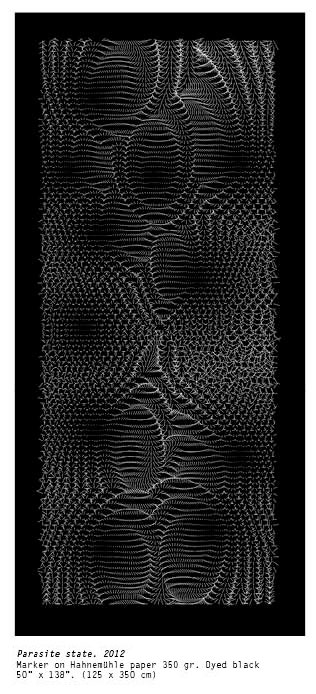
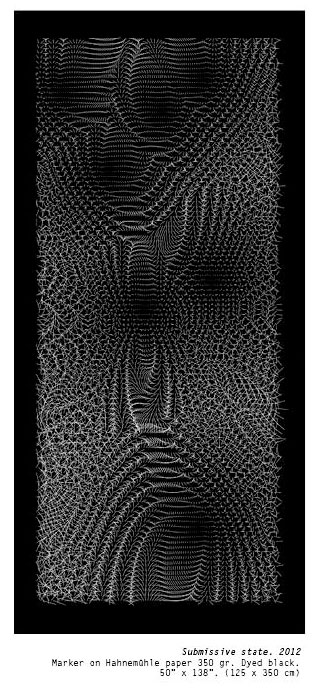
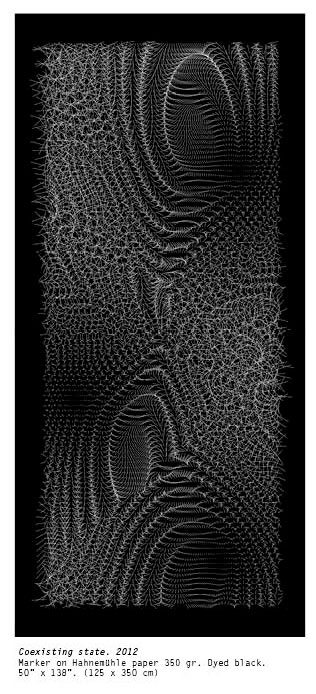
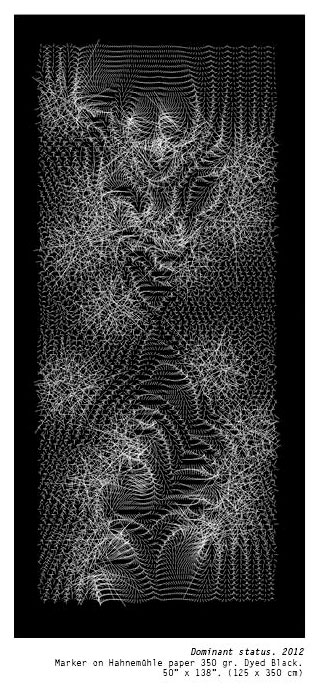

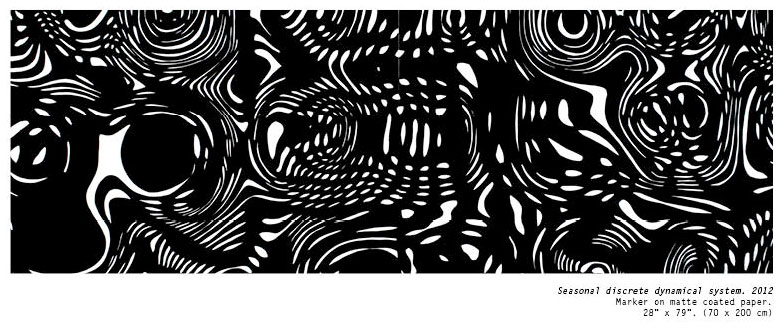
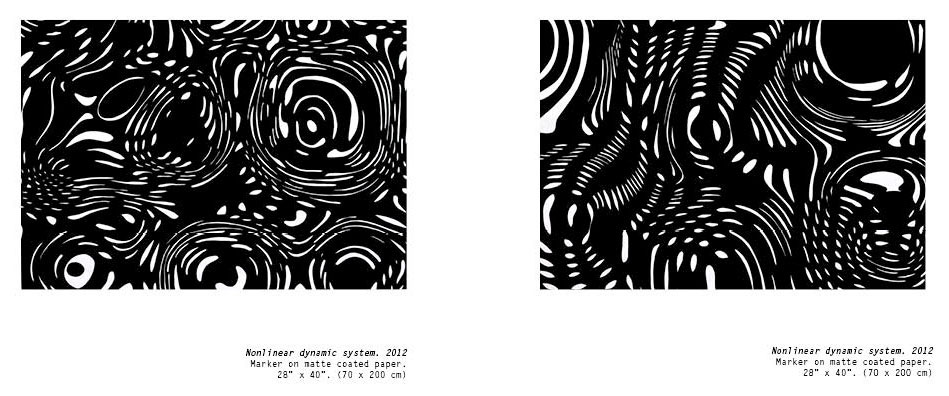
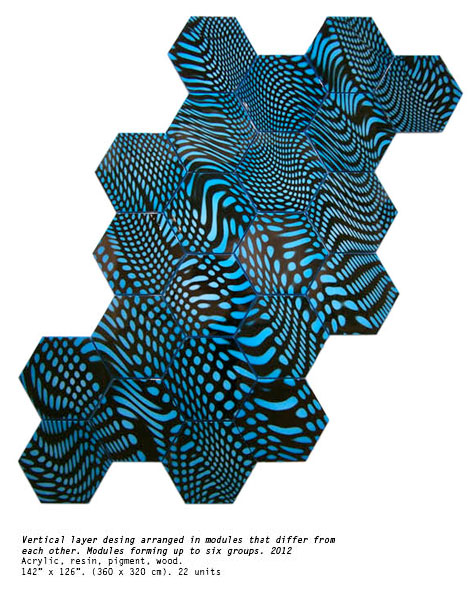
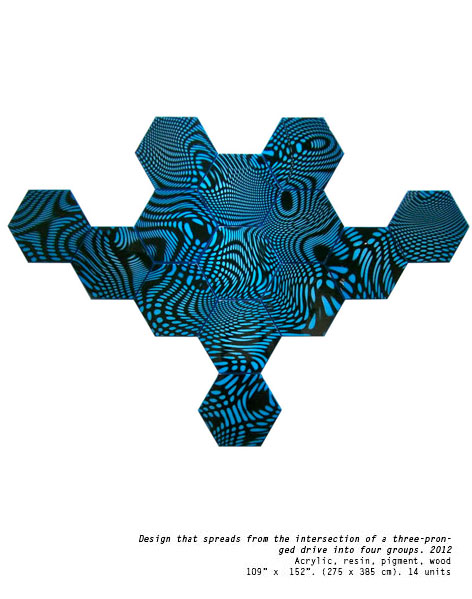
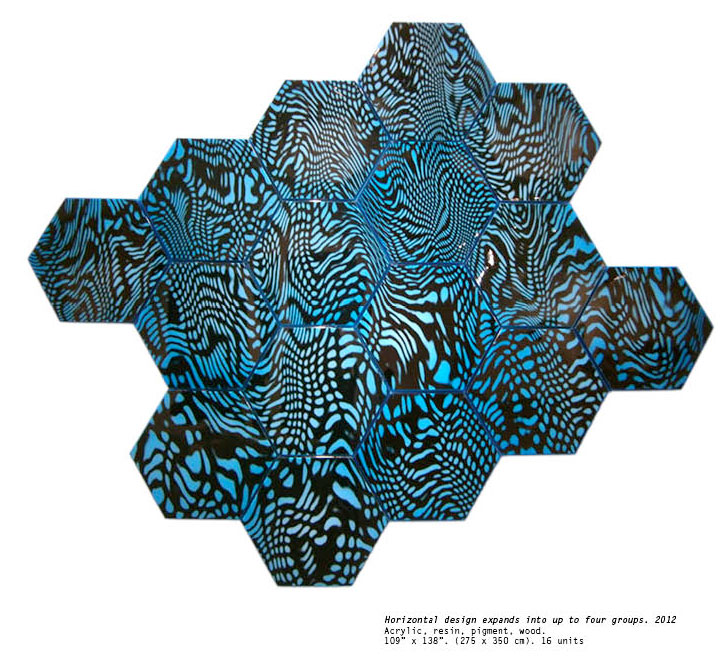
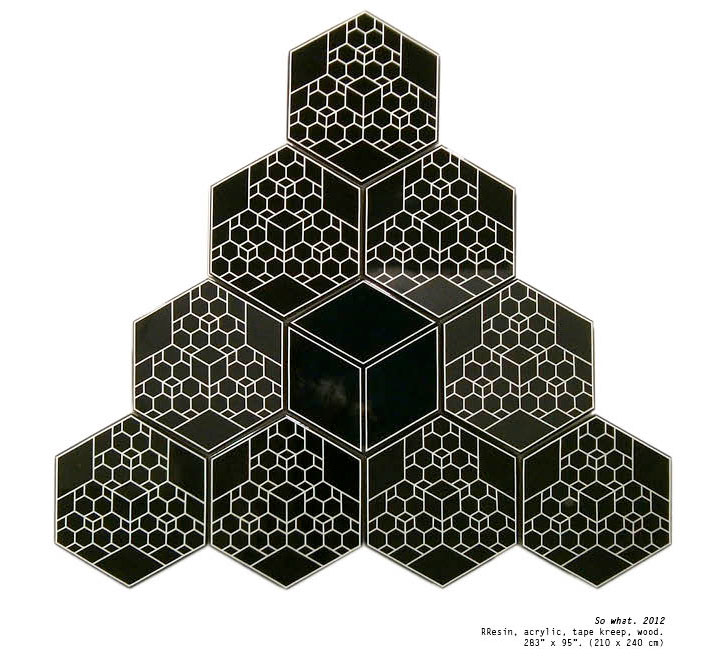

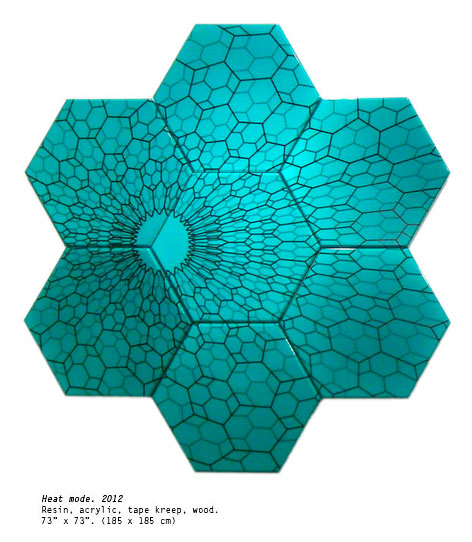
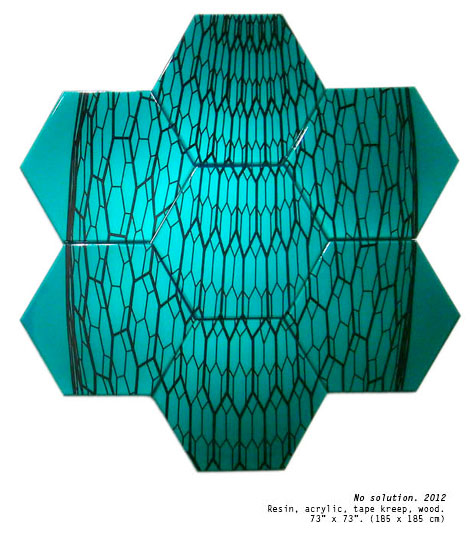
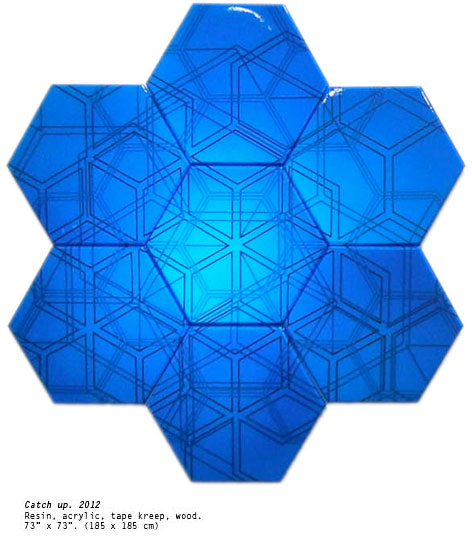
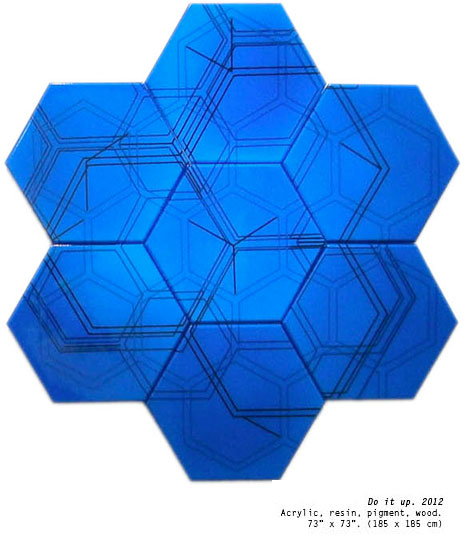



Bachelor´s Degree in Fine Arts (5 years) University of Salamanca. He has led workshops with Giri Dokoupil, José María Larrondo or Simón Marchan Fiz.
Since 1996 he has set up more than twenty individual exhibitions, the most remarkable being: Trá-fico de Arte Gallery, León (1996/ 2001/ 2004/ 2005), Condes of Gabia Palace, Granada (1998), Cal-derón Theater, Valladolid (1999), Diputación Provincial of Málaga (2000), Gustavo de Maeztu Mu-seum, Navarra (2001), Pabellón of Mixtos of the Ciudadela, Pamplona (2006), Forum of Maia, Oporto (2007) and JM Gallery, Málaga (2005/2007/2010).
Standing out among his most important collective exhibitions: Match Box (Laboral, Centre of Art and Industrial Creation, Gijón 2010), Bienal Unicaja of Plastic Arts (Málaga 2008), 67 Interna-tional Exhibition (Valdepeñas 2006), MECA (Almería 2005), Museum of Ciudad Real (2004), IX Com-petition for Fundación La Gaceta Painting (Salamanca 2004), XV Adaja Award for Painting (2003), Abstractions:Navarra´s Current Painting (Pamplona 2002), Young Award for Plastic Arts (Madrid 2001), Museum of Navarra (2001), Teixera Lopes Museum (Oporto 1998).
His work has been featured in Fairs such as ARCO, HOT ART. Basel, Switzerland, ARTE LISBOA and ARTSALAMANCA.
He has been awarded with numerous prizes and grants, the most outstanding being: Acquisition of Work at the Competition for Plastic Arts (Gobierno of Cantabria 2006), Plastic Arts Competition (Junta of Castilla and León 2003/ 2001/1999/1997), VI Unicaja Competition (Málaga 2000), First Award at the COAL Competition (León 2005), First Prize Competition for Painting, Carriegos (León 2004), First Prize for Painting, Caja España (1998), First Prize 14th Competition for Young Ar-tists (1998). He has received funding for the production of the Pablo Ruiz Picasso Foundation (Málaga 2001), Junta of Castilla and León (2001/ 2000), Navarra Government (1996).